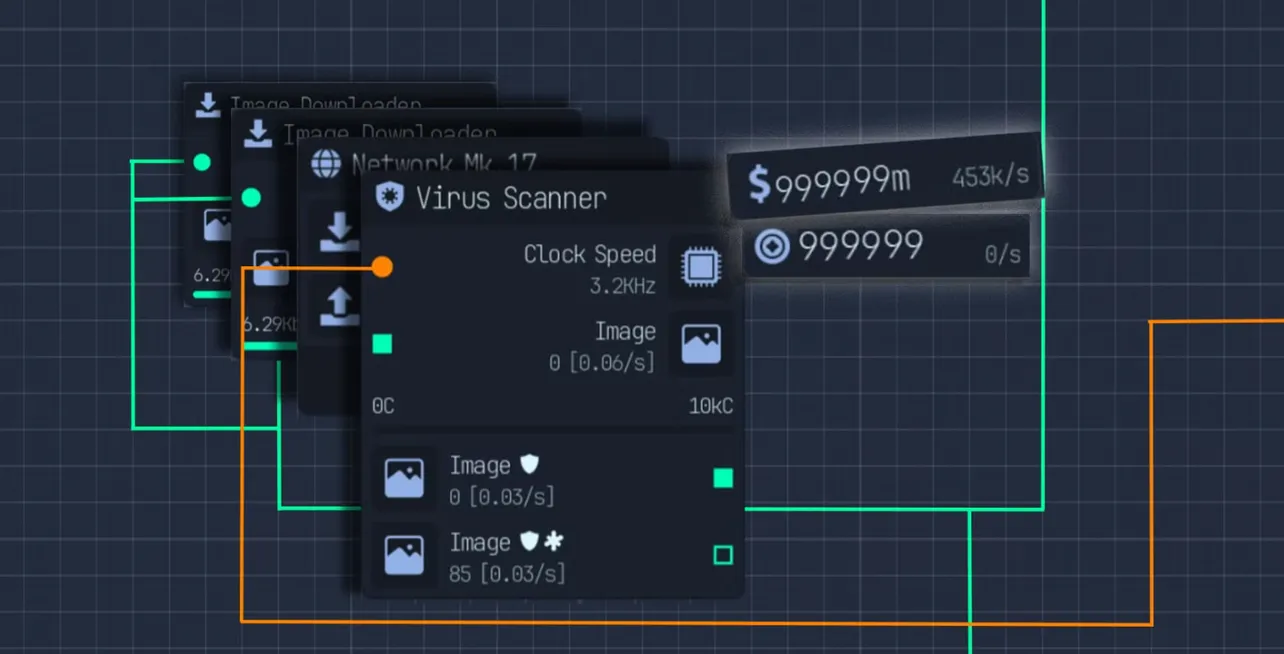Crypto in Upload Labs is a separate money machine. Instead of trickling income, it delivers lump sums when you decide to sell. It runs on its own production chain, so it doesn’t siphon Network or Clock Speed from your main upload lines. Treat it like a side pipeline you spin up, stockpile, then cash out at the right moment.
Set up the GPU→Miner→Seller chain (the only path that works)
Crypto unlocks when you add a GPU Node (the one with the fan icon). From there, you’re building a simple chain: GPU power feeds a Miner, and the Miner’s output feeds a Crypto Seller that turns coins into cash.
- Place a GPU Node, then add up to five GPU cores. Each core produces the same processing speed, measured in Hz.
- (Optional) Place a GPU Synchronizer and connect cores to it to combine their power.
- Place a Miner Node and choose a single cryptocurrency to mine.
- Attach either one GPU Core or a Synchronizer to that Miner (one input per Miner).
- Attach a Crypto Seller Node to the Miner’s output. Without a Seller, mined coins just sit there.
- Sell your coins by clicking Sell on the Seller, or assign an Auto Crypto Seller to trigger sales at a defined price threshold.
That’s the whole loop: GPUs generate power → Miners turn that power into coins → Sellers convert coins to cash on demand.
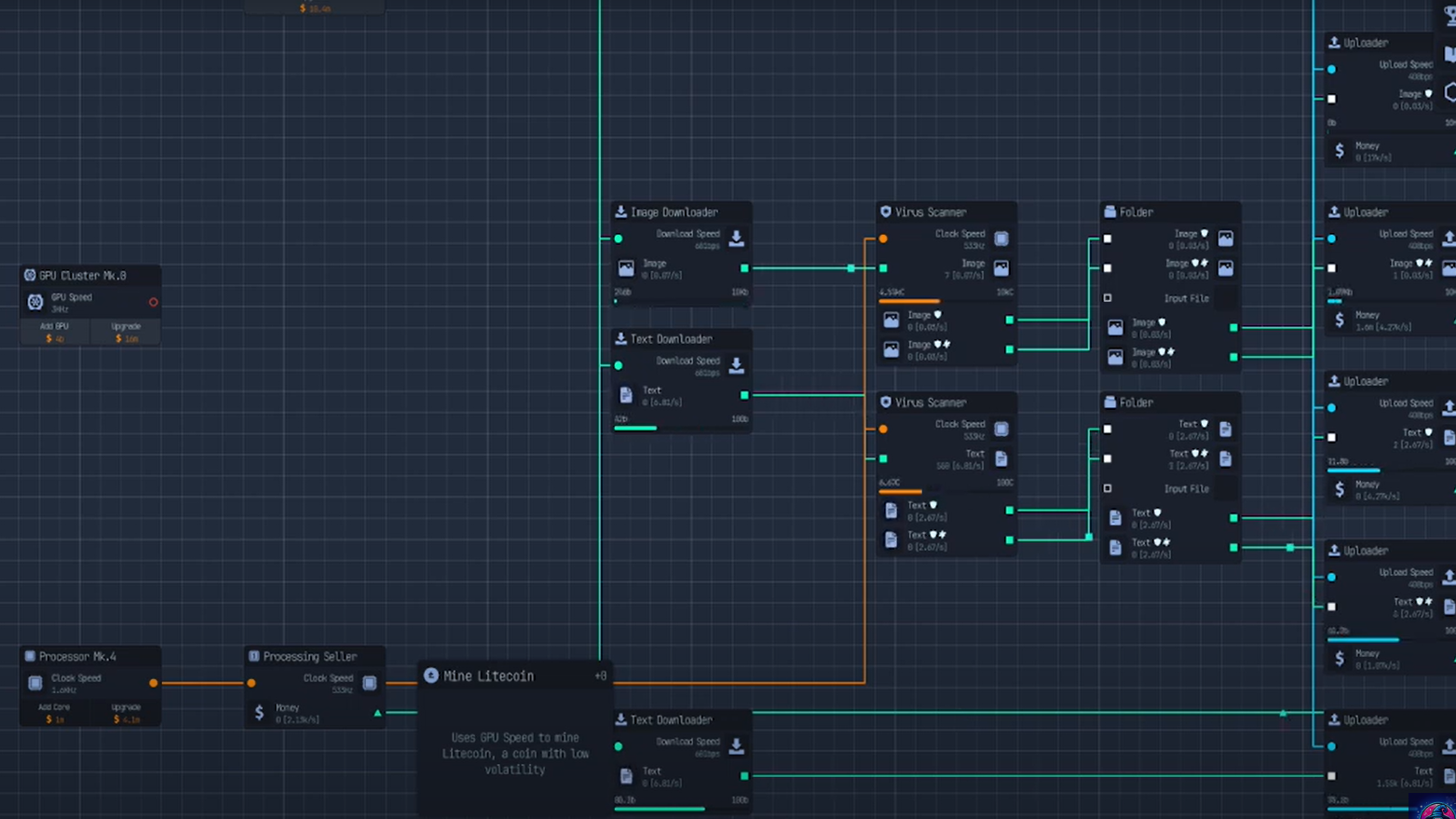
Crypto volatility (why timing your sale matters)
Every mineable coin in Upload Labs has a fixed base value. The sell price then moves up or down every second around that base. A coin’s volatility determines how far it can swing in either direction. The game only converts your stored coins into cash when you sell, so patience is rewarded. Ideally, you stockpile coins, then sell into a spike.
Don’t want to watch a graph? Enable the Auto Crypto Seller and set a threshold. It will offload the stash the moment your target price hits, sparing you the active monitoring.
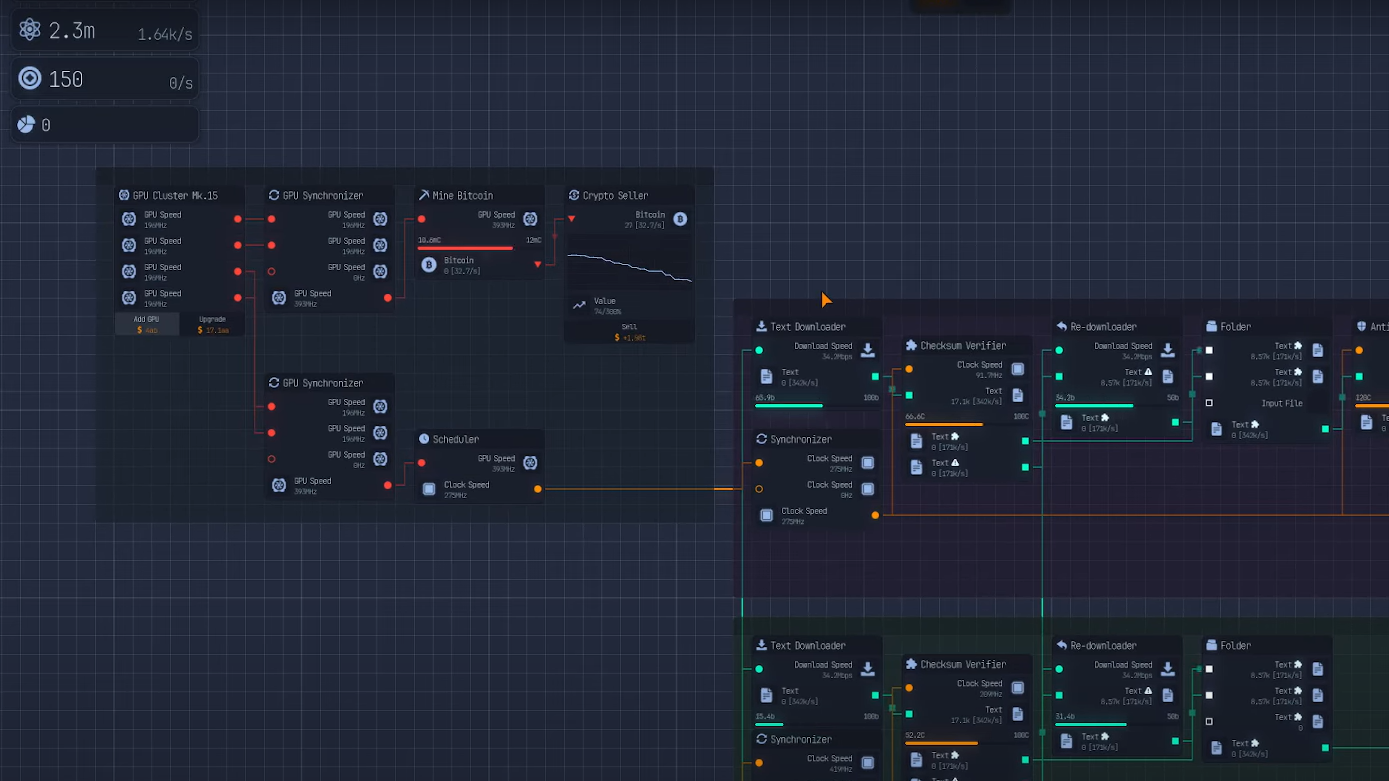
Which coin to mine (Litecoin, Bitcoin, Etherium, or Tether)
Choice is gated by progression. Litecoin is available as soon as you unlock GPUs. Bitcoin and Etherium arrive via the Research Tree. Tether is unlocked with Tokens and behaves differently.
| Coin | Power needed | Base price (100%) | Lowest price | Highest price |
|---|---|---|---|---|
| Litecoin | 60kC | 1.2m | 600k | 2.4m |
| Bitcoin | 12mC | 200m | 66m | 600m |
| Etherium | 3mC | 60m | 12m | 300m |
- Litecoin: Lowest power requirements, lowest pay. Good as a starter or when GPU power is scarce.
- Bitcoin: Heavy power, steady high value even near the low end of its band.
- Etherium: Moderate power, high volatility. Best upside if you’re willing to wait for peak price.
- Tether: No price swings. Converts GPU power straight into cash. Lower ceiling, but you get an immediate, predictable income.
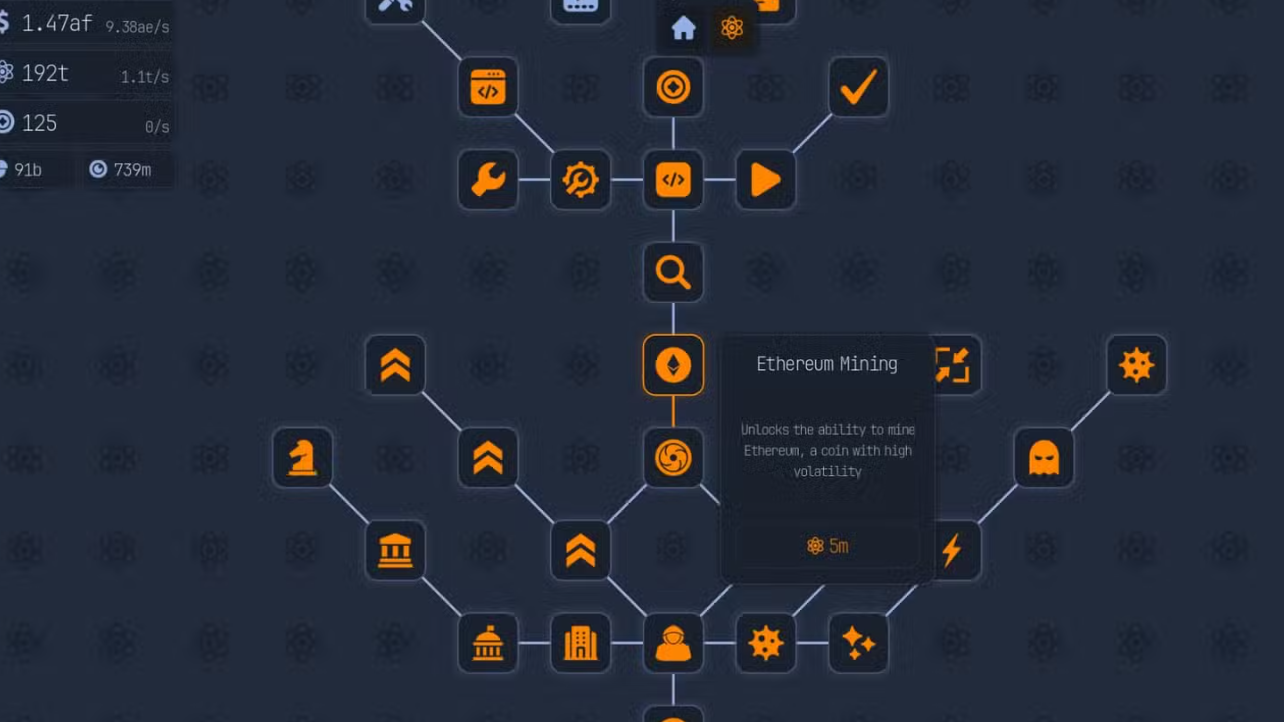
One turbo miner or five parallel miners (how to route your GPU cores)
A GPU can feed up to five Miners (one core per Miner) or you can funnel the entire card’s output through a Synchronizer into one Miner. Both configurations are valid:
- Five miners: More simultaneous coins, less micromanagement if you’re running lower‑volatility targets. Works fine with Litecoin or if you prefer frequent, smaller sells.
- One synchronized miner: Maximum throughput into a single coin. This pairs well with high‑volatility Etherium when you’re timing for a top tick.
Where the math lands: Etherium vs Bitcoin vs Litecoin
When all GPU power is dedicated to one Miner via a Synchronizer, Etherium is produced roughly four times faster than Bitcoin. With volatility on your side, that throughput multiplies your payout at peak price.
A simple comparison at each coin’s upper bound illustrates the gap:
- Bitcoin at its high: selling 100 coins at 600m yields 60b.
- Etherium at its high: selling 400 coins at 300m yields 120b.
You’re earning double in this scenario by leaning into Etherium’s volatility and production rate. The tradeoff is patience: high‑volatility peaks arrive less often, so you may wait longer between cashouts.
Use this as a rule of thumb, not a mandate:
- Time‑rich, power‑focused: Synchronize into Etherium and sell only at the top of its band.
- Value‑steady: Mine Bitcoin if you want high value even on dips.
- Power‑limited or early: Mine Litecoin to keep coins trickling while you build out.
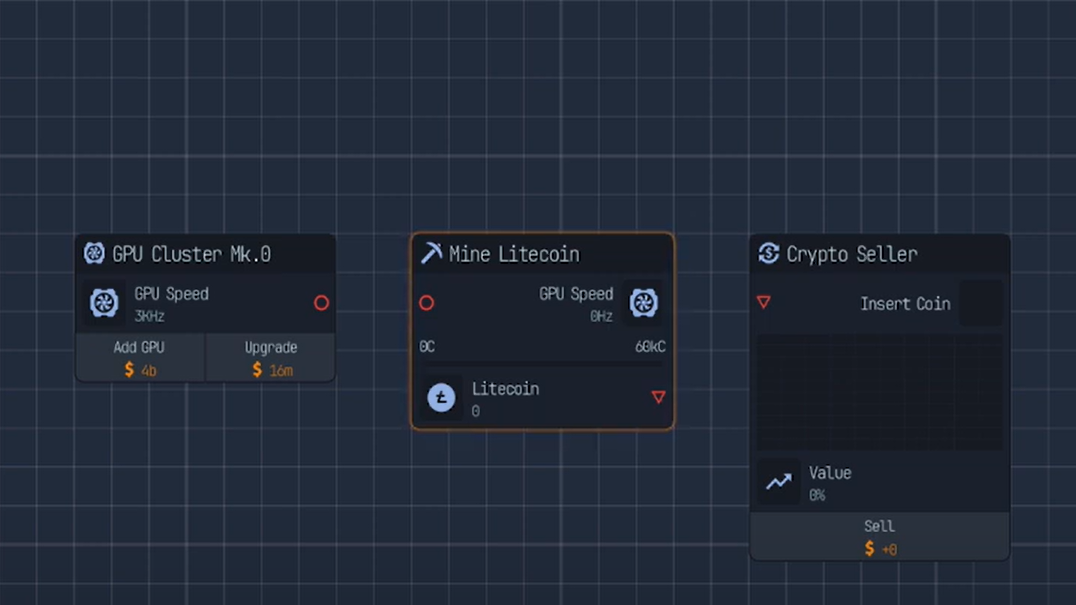
Auto Crypto Seller and Tether (hands‑off options)
If you prefer to set a plan and walk away, two tools help:
- Auto Crypto Seller: Attach it to a coin and set a threshold so it pushes out sales when your target price hits. This preserves the “sell the spike” advantage without babysitting the chart.
- Tether: Skip volatility entirely and turn GPU power directly into cash. You’ll sacrifice maximum profit, but your income becomes predictable and immediate.
Both options reduce clicks; use them when you’re juggling other parts of the base or leaving a session running.
Practical build flow (short, repeatable, upgrade‑friendly)
- Unlock and place a GPU Node, add as many cores as you can afford.
- Decide routing: five Miners (one core each) or one synchronized Miner (all cores combined).
- On each Miner, select the coin you want to target.
- Attach a Crypto Seller Node to each Miner’s output.
- For active play, sell on spikes. For passive play, assign Auto Crypto Sellers with sensible thresholds.
- As you expand, rebalance between Litecoin/Bitcoin/Etherium/Tether based on your power budget and how closely you plan to watch prices.
Where crypto fits in your progression
Crypto shines as a funding lever for big upgrades: it’s a separate pipeline, it scales with your GPU spend, and it pays out in chunky bursts when you time sales. As your build grows, you may want to redirect some GPU power to other systems, which naturally reduces crypto throughput. That’s fine—leave an Auto Seller on a high‑value coin or switch to Tether for reliable background cash while your main graph does the heavy lifting elsewhere.
The core idea doesn’t change: push as much GPU power as you can spare into the coin that matches your playstyle, let coins accumulate, and sell at smart prices. Etherium pays best at the top, Bitcoin is solid across its range, Litecoin gets you started, and Tether turns GPUs into steady money with no drama.

